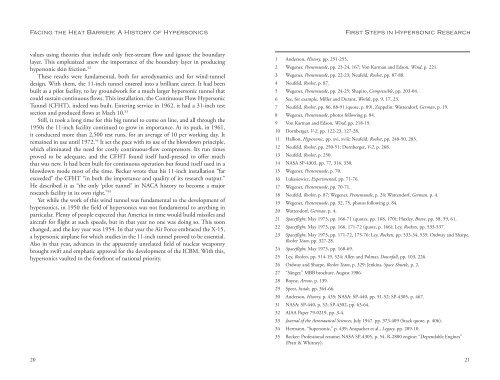Facing the Heat Barrier - NASA's History Office
Facing the Heat Barrier - NASA's History Office
Facing the Heat Barrier - NASA's History Office
You also want an ePaper? Increase the reach of your titles
YUMPU automatically turns print PDFs into web optimized ePapers that Google loves.
<strong>Facing</strong> <strong>the</strong> <strong>Heat</strong> <strong>Barrier</strong>: A <strong>History</strong> of Hypersonics<br />
values using <strong>the</strong>ories that include only free-stream flow and ignore <strong>the</strong> boundary<br />
layer. This emphasized anew <strong>the</strong> importance of <strong>the</strong> boundary layer in producing<br />
hypersonic skin friction. 52<br />
These results were fundamental, both for aerodynamics and for wind-tunnel<br />
design. With <strong>the</strong>m, <strong>the</strong> 11-inch tunnel entered into a brilliant career. It had been<br />
built as a pilot facility, to lay groundwork for a much larger hypersonic tunnel that<br />
could sustain continuous flows. This installation, <strong>the</strong> Continuous Flow Hypersonic<br />
Tunnel (CFHT), indeed was built. Entering service in 1962, it had a 31-inch test<br />
section and produced flows at Mach 10. 53<br />
Still, it took a long time for this big tunnel to come on line, and all through <strong>the</strong><br />
1950s <strong>the</strong> 11-inch facility continued to grow in importance. At its peak, in 1961,<br />
it conducted more than 2,500 test runs, for an average of 10 per working day. It<br />
remained in use until 1972. 54 It set <strong>the</strong> pace with its use of <strong>the</strong> blowdown principle,<br />
which eliminated <strong>the</strong> need for costly continuous-flow compressors. Its run times<br />
proved to be adequate, and <strong>the</strong> CFHT found itself hard-pressed to offer much<br />
that was new. It had been built for continuous operation but found itself used in a<br />
blowdown mode most of <strong>the</strong> time. Becker wrote that his 11-inch installation “far<br />
exceeded” <strong>the</strong> CFHT “in both <strong>the</strong> importance and quality of its research output.”<br />
He described it as “<strong>the</strong> only ‘pilot tunnel’ in NACA history to become a major<br />
research facility in its own right.” 55<br />
Yet while <strong>the</strong> work of this wind tunnel was fundamental to <strong>the</strong> development of<br />
hypersonics, in 1950 <strong>the</strong> field of hypersonics was not fundamental to anything in<br />
particular. Plenty of people expected that America in time would build missiles and<br />
aircraft for flight at such speeds, but in that year no one was doing so. This soon<br />
changed, and <strong>the</strong> key year was 1954. In that year <strong>the</strong> Air Force embraced <strong>the</strong> X-15,<br />
a hypersonic airplane for which studies in <strong>the</strong> 11-inch tunnel proved to be essential.<br />
Also in that year, advances in <strong>the</strong> apparently unrelated field of nuclear weaponry<br />
brought swift and emphatic approval for <strong>the</strong> development of <strong>the</strong> ICBM. With this,<br />
hypersonics vaulted to <strong>the</strong> forefront of national priority.<br />
20<br />
First Steps in Hypersonic Research<br />
1 Anderson, <strong>History</strong>, pp. 251-255.<br />
2 Wegener, Peenemunde, pp. 23-24, 167; Von Karman and Edson, Wind, p. 221.<br />
3 Wegener, Peenemunde, pp. 22-23; Neufeld, Rocket, pp. 87-88.<br />
4 Neufeld, Rocket, p. 87.<br />
5 Wegener, Peenemunde, pp. 24-25; Shapiro, Compressible, pp. 203-04.<br />
6 See, for example, Miller and Durant, Worlds, pp. 9, 17, 23.<br />
7 Neufeld, Rocket, pp. 86, 88-91 (quote, p. 89). Zeppelin: Wattendorf, German, p. 19.<br />
8 Wegener, Peenemunde, photos following p. 84.<br />
9 Von Karman and Edson, Wind, pp. 218-19.<br />
10 Dornberger, V-2, pp. 122-23, 127-28.<br />
11 Hallion, Hypersonic, pp. xvi, xviii; Neufeld, Rocket, pp. 248-50, 283.<br />
12 Neufeld, Rocket, pp. 250-51; Dornberger, V-2, p. 268.<br />
13 Neufeld, Rocket, p. 250.<br />
14 NASA SP-4303, pp. 77, 316, 330.<br />
15 Wegener, Peenemunde, p. 70.<br />
16 Lukasiewicz, Experimental, pp. 71-76.<br />
17 Wegener, Peenemunde, pp. 70-71.<br />
18 Neufeld, Rocket, p. 87; Wegener, Peenemunde, p. 24; Wattendorf, German, p. 4.<br />
19 Wegener, Peenemunde, pp. 32, 75, photos following p. 84.<br />
20 Wattendorf, German, p. 4.<br />
21 Spaceflight, May 1973, pp. 166-71 (quotes, pp. 168, 170); Huxley, Brave, pp. 58, 59, 61.<br />
22 Spaceflight, May 1973, pp. 166, 171-72 (quote, p. 166); Ley, Rockets, pp. 533-537.<br />
23 Spaceflight, May 1973, pp. 171-72, 175-76; Ley, Rockets, pp. 533-34, 535; Ordway and Sharpe,<br />
Rocket Team, pp. 327-28.<br />
24 Spaceflight, May 1973, pp. 168-69.<br />
25 Ley, Rockets, pp. 514-19, 524; Allen and Polmar, Downfall, pp. 103, 226.<br />
26 Ordway and Sharpe, Rocket Team, p. 329; Jenkins, Space Shuttle, p. 2.<br />
27 “Sänger.” MBB brochure, August 1986.<br />
28 Boyne, Arrow, p. 139.<br />
29 Speer, Inside, pp. 364-66.<br />
30 Anderson, <strong>History</strong>, p. 435; NASA: SP-440, pp. 51-52; SP-4305, p. 467.<br />
31 NASA: SP-440, p. 52; SP-4302, pp. 63-64.<br />
32 AIAA Paper 79-0219, pp. 3-4.<br />
33 Journal of <strong>the</strong> Aeronautical Sciences, July 1947. pp. 373-409 (Stack quote, p. 406).<br />
34 Hermann, “Supersonic,” p. 439; Anspacher et al., Legacy, pp. 209-10.<br />
35 Becker: Professional resume; NASA SP-4305, p. 54. R-2800 engine: “Dependable Engines”<br />
(Pratt & Whitney).<br />
21
















